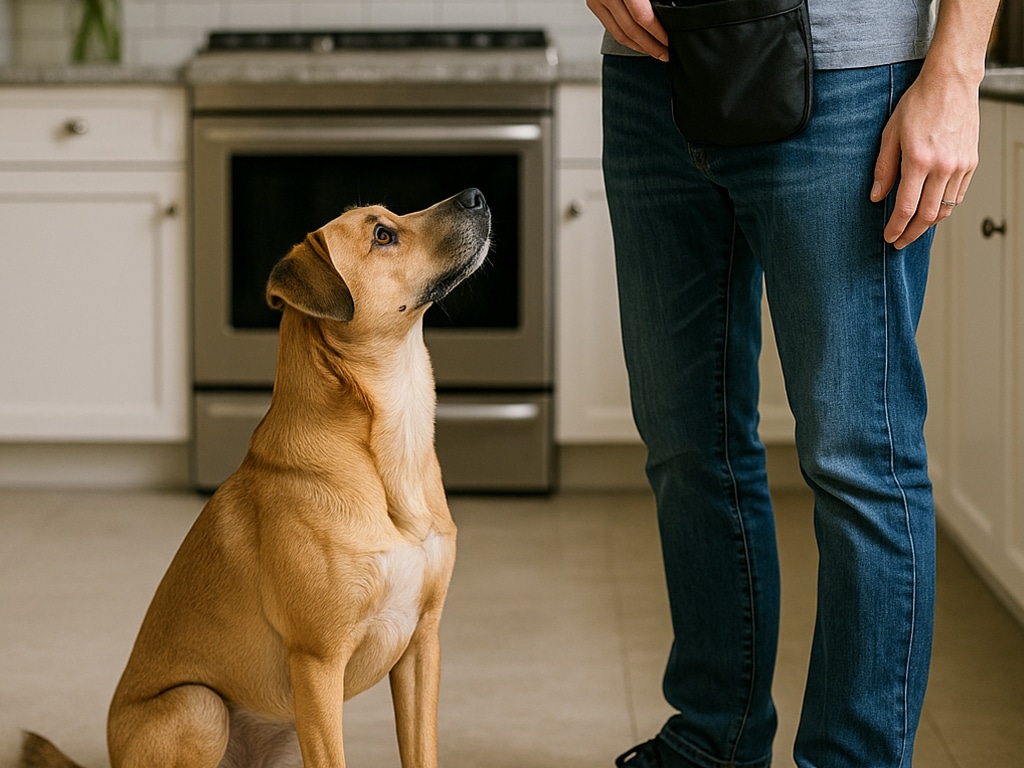Every behaviour your dog offers—from the frustrating to the fantastic—has a reason behind it. It’s not random. It’s not personal. It’s strategic. At K9 Principles, we don’t chase symptoms or use outdated theories. We look at behaviour through the lens of motivation. Because once you understand what’s fuelling your dog’s choices, you can change everything—clearly, calmly, and for good.
The Core Truth: Dogs Behave in Ways That Work for Them
If you only remember one principle from all the dog training advice you’ve ever heard, let it be this: dogs do what works. Every action they take—whether it’s sitting calmly or pulling you down the street—is a behaviour they’ve learned either creates a desired result or prevents something undesirable. They are not moral creatures choosing between right and wrong. They are pragmatic learners making choices based on outcomes.
When we say a dog is trying to “better its own situation,” we’re speaking to a universal truth grounded in behavioural science. It means that dogs repeat behaviours that are reinforced. If a behaviour leads to something the dog wants—attention, food, freedom, stimulation, affection, distance, or control—it becomes stronger and more likely to happen again. If it leads to nothing of value, or worse, creates discomfort, it will gradually fade unless something else is keeping it alive.
This is why the same dog can be an angel at home and a nightmare in public. The environment changes the consequence. It’s also why dogs seem to “forget” cues when they’re emotionally aroused or overstimulated—because they’re not prioritising your words, they’re reacting to what works in that moment. They’re not being disobedient. They’re being efficient.
Reinforcement Is the Architect of All Behaviour
Everything your dog does is built on the scaffolding of reinforcement. Whether that reinforcement is deliberate (like giving a treat for sitting) or accidental (like laughing when they steal a sock), your dog is constantly reading the room and filing away what behaviour got the best result. That result might be a physical item, a sensory experience, a social interaction, or an emotional shift.

When your dog barks and the person at the door backs away, they experience relief. When they pull on the lead and reach a scent they wanted, they experience satisfaction. When they nip during play and the game continues, they experience success. Even behaviours that seem pointless or annoying often carry hidden reinforcement. Licking, pacing, whining, stealing laundry—if the outcome is rewarding, the behaviour gets logged in their brain as useful.
This reinforcement doesn’t have to come from you. The environment itself is full of reinforcers. A squirrel, a smell, a splash in a puddle—all of these can outweigh whatever treat is in your pouch if they offer more value in that moment. That’s why many obedience cues crumble under distraction—not because the dog is ignoring you out of defiance, but because the alternative is simply more powerful.
And here’s where most training systems fall apart. They assume that dogs will just listen out of duty or habit. But the truth is that every cue, every rule, and every boundary needs to be paired with a meaningful reason for the dog to follow it. That reason is reinforcement—and it has to be consistent, timely, and relevant to what your dog finds rewarding.
Your Dog’s Motivation System Is a Living Algorithm
Think of your dog’s behaviour as being powered by a constantly updating algorithm. Each time they act, they measure the outcome. If the outcome improves their emotional or physical state, that behaviour gets prioritised in future situations. If the outcome is neutral or negative, that behaviour gets demoted. But here’s the nuance: some behaviours are reinforced even when they seem ineffective. For example, a dog might bark for five minutes and then get let inside. To the human, it was an annoying delay. To the dog, the barking eventually opened the door—and that’s what sticks.
This internal feedback loop is always running. It’s how dogs learn. And if you don’t take control of that loop, it will be shaped by chance, chaos, and conflicting consequences. That’s why consistency is everything in dog training. If your dog sometimes gets ignored for barking and sometimes gets attention, the behaviour becomes more persistent because of what’s called an intermittent reinforcement schedule. In psychology, this is the same pattern used by casinos and slot machines—it creates stubborn, compulsive habits.
To change a behaviour, you must change the data your dog is receiving. That means stripping reinforcement away from behaviours you don’t want, and pouring value into behaviours you do. That doesn’t mean yelling, punishing, or suppressing. It means understanding what your dog is really working for in that moment—and teaching them a better way to achieve it.
No Behaviour Happens in a Void—It’s Always Serving a Function

All dog behaviour serves a purpose. That purpose might be sensory (relieving discomfort), emotional (reducing anxiety), communicative (gaining attention), or environmental (accessing space or resources). When we label a behaviour as “problematic,” what we’re really saying is that the behaviour works for the dog, but doesn’t work for us. The dog isn’t malfunctioning. They’re just choosing something that benefits them within their current understanding of the world.
Let’s say your dog jumps on visitors. You might hate it, but to your dog, it gets them closer to the people they’re excited about. That closeness is rewarding. If the guests give them eye contact, speak to them, or push them down, those interactions still reinforce the behaviour. If you want to change that jumping, you can’t just say “off” or scold. You have to show your dog a behaviour that gets them the same social payoff in a more structured way—like a sit-stay with permission to greet calmly.
Another common example is barking out the window. From the dog’s point of view, the barking makes the person or animal outside go away. Even though you know the passerby wasn’t coming in, your dog doesn’t understand that. They see that their barking made the trigger disappear. That’s a powerful reinforcer. Telling your dog “quiet” in that moment usually adds fuel to the fire. They believe you’re barking with them, or at least joining the action. The real fix is blocking rehearsal, training an incompatible behaviour like going to a mat, and reinforcing silence until it becomes the new habit.
In every case, the behaviour is logical if you look at it through the dog’s eyes. They’re not challenging you. They’re choosing a strategy that worked in the past. It’s your job to make a different strategy work even better.
Why Moral Judgements Have No Place in Dog Training
One of the biggest obstacles to progress in training is the human tendency to assign intention or morality to our dogs’ actions. We say things like, “He knows better,” or “She’s just being naughty.” These statements are emotionally charged, but behaviourally inaccurate. Dogs don’t operate from guilt, revenge, or shame. They operate from patterns and consequences.
When your dog refuses a cue or breaks a rule, they’re not making a moral decision. They’re assessing what’s most valuable at that moment. If your reward history is weak, or the environment is more stimulating, their choice is simple—they do what pays off best.
This is not a sign of rebellion. It’s a sign that training needs more clarity and reinforcement. At K9 Principles, we don’t waste time getting offended by behaviour. We focus on creating clean, consistent feedback loops that make the right choice easy and obvious. We teach the dog what to do, and we teach the owner how to reinforce it in ways that matter to their dog—not just to them.
When you remove moral judgement from the equation, you start to see behaviour with compassion and strategy instead of frustration. That shift doesn’t just improve training—it transforms your entire relationship.
Behaviour is Contextual, Not Generalised
Many dog owners fall into the trap of assuming that once a dog learns a behaviour, it’s locked in. But that’s not how canine learning works. Dogs are contextual learners. That means they link behaviours to specific environments, body language, tones, and visual cues. Just because your dog can perform a perfect “stay” in your living room doesn’t mean they can hold it at the park during a soccer game.
Generalising behaviour takes repetition in different places, with increasing levels of distraction, under varied conditions. This process is called proofing, and it’s where most training breaks down. Without proofing, the behaviour is fragile. It’s tied to one room, one situation, one reward history. That’s why your dog might ignore you in public even though they “know” the cue—they haven’t learned to perform that cue in the context you’re asking.

At K9 Principles, we build reliability through context expansion. We train the same behaviour in the home, in the back yard, at the front door, on the street, and in real-world environments around Hamilton. We teach dogs that listening doesn’t just work in one place—it works everywhere. And we make sure it pays off no matter where you are, so your dog doesn’t just follow the rules—they want to.
True Training is About Shaping Desire, Not Enforcing Rules
The most effective training isn’t about controlling behaviour. It’s about influencing choice. That influence comes from understanding your dog’s motivation and teaching them that the right behaviour doesn’t just avoid a consequence—it produces a better one.
When your dog learns that coming when called leads to something amazing, they’ll come with enthusiasm. When they discover that calm behaviour leads to attention, access, and praise, they’ll begin offering it naturally. When loose-lead walking becomes the fastest way to reach the park, pulling fades without conflict.
This is how we train at K9 Principles. We don’t just suppress the behaviours we dislike. We build the behaviours we want until they become stronger, more consistent, and more enjoyable for the dog. We create a learning system where your dog wants to get it right—not because they fear punishment, but because doing it right works better.
This mindset shift—from obedience to motivation—is the difference between temporary control and lasting transformation.
Conclusion: Change the Outcome, and You’ll Change the Behaviour
Dogs do what they do to better their own situation. That’s not a slogan. It’s the single most important behavioural truth in dog training. Once you see behaviour through this lens, everything changes. You stop guessing. You stop blaming. And you start creating training plans that actually work—because they’re built on what your dog is already trying to tell you.
If a behaviour is still happening, it’s still working. If it’s not working, it will stop. If you want a new behaviour, you need to make it more valuable than the old one. And if you want that change to last, it has to make sense to your dog—not just to you.
At K9 Principles, we don’t fix dogs. We teach them. We guide them. And we help them understand that the behaviours you want are the ones that pay off the most.
That’s real dog training. And it starts right here.
Contact us for more information:
- Name: K9 Principles
- Address: Haldimand County, Greater Hamilton Area, Burlington, and Most of Norfolk County
- Phone: 289 880-3382
- Email: k9principlesinc@gmail.com
- Website: www.k9principles.ca
FAQs
-
A1. No. Most likely, your dog has learned that ignoring you either gets them what they want faster—or costs them nothing. It’s not personal. It’s about payoff.






